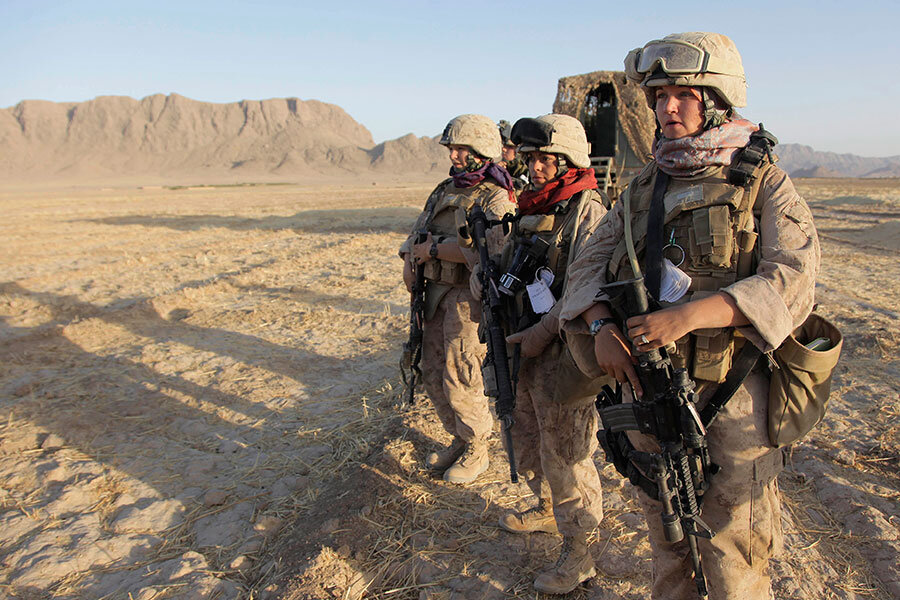Exclusive: US Marine memo hints at shift on women in combat
Loading...
| Washington
A 33-page Marine Corps memo obtained by The Christian Science Monitor suggests that, behind the scenes, the Marines are already talking about how they can integrate women into combat units.
The memo gives a fuller and more nuanced assessment of a Marine gender integration study than a shorter summary released earlier this month. According to the four-page summary made public on Sept. 10, the study found that women were worse shooters than men, got injured more often, and would be a detriment to unit cohesiveness. It prompted a strong backlash from women's groups, who said it was biased and poorly conducted.
The longer memo still concludes that many coed units performed worse than all-male units, and it raises fresh doubts about female Marines' abilities.
But it also suggests that clear occupational standards will mitigate deep concerns that women would lower the effectiveness of the force. Indeed, it notes that "all" of the injuries sustained by the women in the study could have been mitigated by better screening.
It also points out the potential benefits of integrating women into the combat ranks, warning of the danger of “marginalizing female Marines due to gender bias and misconceptions about female performance.”
The memo, signed by Brig. Gen. George Smith on Aug. 18, was addressed to the commandant of the Marine Corps, Gen. Joseph Dunford, who will assume the job of the nation’s top military officer when Gen. Martin Dempsey retires as chairman of the Joint Chiefs of Staff later this month.
Debate around the issue of women in combat is gaining urgency. By January, the military services must open their combat positions to women or ask for an exemption, backed by scientific evidence.
On one hand, the newly obtained memo appears to embrace the Marines' longstanding view that women cannot cope with infantry requirements.
Noting the “timeless, brutal, physical and absolutely unforgiving nature of close combat,” the memo argues that those facts could adversely affect women in the force. The service “risks losing a number of highly talented female Marines prematurely due largely to the often extreme physical demands” of the infantry, Brigadier General Smith writes.
Men in Marine infantry units, too, face famously high levels of burnout. But the memo suggests that any “downward trend in retaining our top female Marines would be a tremendous loss for the Corps.”
The memo also suggests that a failure to meet the infantry's high standards could create frustration among female Marines. “The likelihood of a female Marine being less competitive in these significantly more physically demanding occupations may adversely impact the Marine Corps’ ability to retain top female talent and enable their progression into more senior ranks.”
On the other hand, the memo lays out practical steps toward bringing women into infantry units. That begins with having clear standards in place, which will make sure female Marines are both up to scratch and accepted by their male peers, Smith argues.
“The critical element of successful policy implementation will be an unwavering adherence to these standards, which will provide reasonable assurance of physical capability while mitigating injuries impacting combat effectiveness.”
If the Marines had used a “stricter physical screening tool” for the women in the gender integration study, “all the female Marines who sustained injury and were dropped” from the infantry training battalion would have been eliminated, notes an addendum to the memo.
These standards will also “be the primary driver in overcoming gender bias through clearly demonstrated performance standards, which is fundamental to a cohesive unit with high morale,” he adds.
The "most critical component" of a successful transition to women in infantry units would be leadership, Smith advises General Dunford.
This means “fully invested and unwavering demonstrations of support by commanders and leaders” who “must set the example for Marines at all levels.”
Without full leadership commitment to embracing women in combat roles, “this integration effort will very likely be fraught with friction and unduly protracted.”
This, he warns, would be “potentially a greater drain on combat effectiveness and unit readiness.”
In addition to leadership, a key will be defining what gender integration success looks like, Smith says, and laying out a plan and policies “designed to ensure success.”








